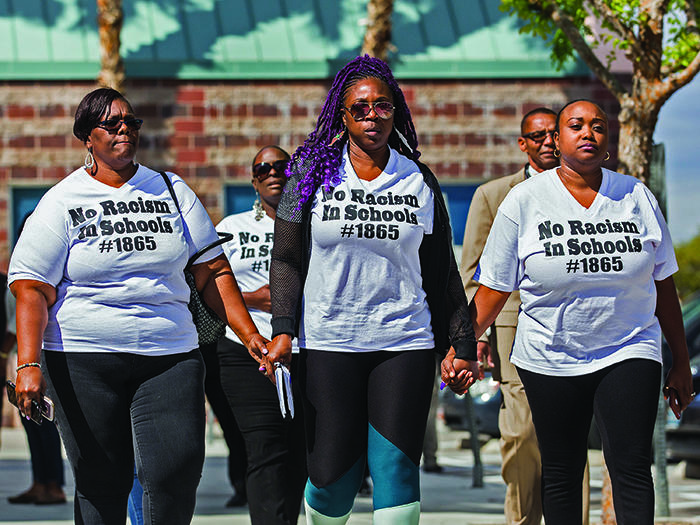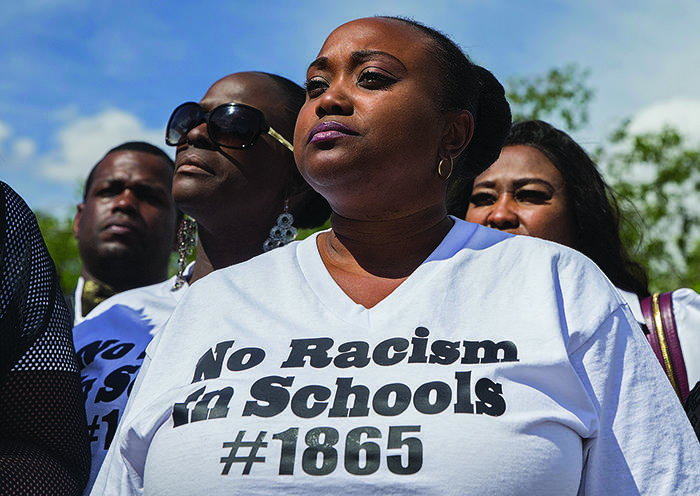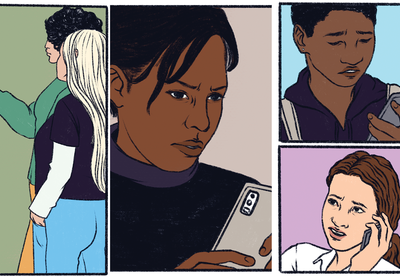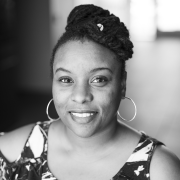Parents in a northwestern Las Vegas community could not have imagined they’d spring into action to ensure the safety of their children one March morning. But it was a natural reaction to learning of racist Instagram posts that threatened physical violence against Black students at Arbor View High School. Some parents were aware of the posts on the evening of March 18. But to their surprise, the students responsible for the posts were still on campus around 10 a.m. the next day. Chaos ensued.
“When I got to school that morning, it was so sad. I was so sad for the students,” says Akiko Cooks, mother of Corey Landrum, one of the targeted students. “Kids were literally running off the campus. Their parents were calling them, saying, ‘Leave now.’ Parents were flying on campus. You’d see people pulling into the parking lot, almost not parking, jumping out, running in and getting their kids.”
The Instagram posts shook the community and spurred a mandate for a better school climate, led by parents.
All of the posts, which accompanied photos of nine randomly selected Black boys on campus, included language like the n-word, “wild monkeys” and “rodents,” or they described violent acts against the targets.
“God just seeing these [n-words] inferioates [sic] me,” one post reads, which was liked by at least two people. “I just wanna go Columbine pt 2 just but only kill the [expletive] [n-words]. I can smell the [expletive] melanin.”
Cooks’ then-15-year-old son couldn’t discern whether it was a joke or a serious threat. He’s still grappling with ways to express his feelings about the incident.
“I thought school was mostly a safe place, but [I] guess not,” Corey says.
Parents, teachers and students across Clark County School District (CCSD), the fifth largest school district in the country, were stunned by the blatant racism shown toward a group of people.
“This is probably the first major incident that I’ve ever seen in Clark County where it was targeting such a specific group and really harshly,” says one teacher, a former student in the district.
Two students responsible for the posts were arrested and charged as juveniles with making terroristic threats, conspiring to commit terroristic threats, breach of peace, cyberbullying and hate crimes. Police also cited a third student for cyberbullying.
One of the teens had access to firearms at his home—a detail that evoked fear in parents and magnified the seriousness of the threat. The teens were sentenced to nine months in a diversion program at a juvenile facility. This program, designed by the district attorney’s office in response to the incident, addresses “bias and racism, as well as the school threats,” according to Clark County’s chief deputy district attorney.
But the sentencing and passage of time did not mean the ordeal was over. Parents, led by Cooks, set out to confront racism at the school, improve safety and heal the targeted students.
“They’re trying to move forward and not allow this incident to shape their future, but I think it will anyway,” Cooks says. “Because at some point, once they get older, they will experience some racism, and this will be a trauma trigger for them.”
The Birth of No Racism in Schools #1865
Ensuring that the students responsible for the threats are held accountable is one thing. Creating a space that prevents such a thing from happening is another. Following the incident, Arbor View administrators welcomed the Anti-Defamation League and the National Equity Project to address issues at the school, which has a Black population of about 15 percent; students of color represent just over half of the student body.
But this move puzzled some parents, as the district already has an Equity and Diversity Department that could be doing that work. Cooks, along with other Arbor View High School families, demanded more from administrators and called for accountability for that department. They also felt educators should do more to address and respond to hate. So they showed up at school board meetings and town hall meetings, and they organized.

Families whose children had graduated years prior were also present at gatherings to express concerns about enduring racism from staff and students.
“They didn’t have students at Arbor View anymore, but they came to make a point,” Cooks says of one town hall meeting. “They said, ‘This has been going on. We’ve been telling you this. These kids have been flying Confederate flags. These teachers have been racist.’”
I want to show my son that you don’t have to kowtow to anybody. All you’ve got to do is be righteous and do the work.
The parents’ campaign became known as No Racism in Schools #1865. Jshauntae Marshall, another parent whose son was targeted in the Instagram posts, works with district administrators to ensure safety protocols are implemented and effective. She’s also pushing to close any disparities and implement equity and diversity trainings for staff.
Cooks focuses on awareness and communications.
“I really hope to reach teachers and educators,” Cooks says, “because for me, [teachers are] either the first line of defense or the problem.”
Members of No Racism in Schools attached the year 1865—the year U.S. slavery was abolished—to their effort because, to them, it represents the mentality they witness in society today. They sense regression to a more troubling time, but it’s also a reminder that Black people have always been fighting—and will continue to fight—to ensure freedom and safety.
Seeking to go beyond the single incident, they came up with demands, including creating a crisis response team and improving mental health services. The district has worked through most of the demands so far.
The group also wants to instill pride in the Black community and motivate them to action. Through the campaign’s Facebook page, Cooks shares upcoming events and articles and messages about Black history and Black achievement.
“Our message is very, very clear,” Cooks says. “This is centered around Black students. But centering something around Black students does not alienate anyone else. It helps everyone. Uplifting a Black student does not kick anybody else down.”
Racist incidents have not been exclusive to Arbor View. Parents learned that students in other CCSD schools had experienced similar problems. Subsequent incidents, such as an antisemitic note at one middle school and a racist video at another high school, gained media attention. It was so pervasive across the district that No Racism in Schools #1865 wanted to tackle that, too.
It’s Not Just Arbor View
After revisiting old grievances other parents had shared at town halls and elsewhere—and sorting through districtwide data that showed racial disparities in suspension and expulsion rates—Arbor View parents understood that their school’s recent hate incident was just a symptom of greater problems.
According to Marshall’s assessment of data she received from district officials, of the 377 schools in a district that serves over 325,000 students, 45 schools were at risk of experiencing a race-related incident primarily because there were racial tensions and alleged racial bias among staff.
No Racism in Schools #1865 quickly became a way to engage more broadly to correct problems around race in the entire district.
In partnership with the education journalism site Nevada Voice, the group encourages communities to speak about difference, bias and the district’s systemic issues through monthly town hall-style meetings.
The overt anti-Black racism in the Arbor View Instagram threats may be a shock to some—even those who live in Las Vegas. However, racial inequality and anti-Blackness were baked into the city’s founding. While Nevada entered the United States as an anti-slavery territory in 1861, the territorial legislature created discriminatory laws that same year—banning Black people from marrying white people, from voting and from testifying in court against white people. Las Vegas was founded in 1905. By the 1920s, parts of Nevada, including Las Vegas, saw Ku Klux Klan demonstrations. And housing and job discrimination against people of color ramped up when construction on the Hoover Dam began in 1931. In “The Mississippi of the West?” author Michael S. Green explains that Black Las Vegans coined that phrase in the 1950s to reflect their experiences there. It’s a phrase that both Cooks and Marshall have referenced.
The reality is that anti-Black racism in the United States has never been restricted to one geographical region. Although it’s largely associated with the antebellum South, slavery was legal in all 13 of the original U.S. colonies. And places like New York, Pennsylvania and California have publicly paid homage to white supremacy with monuments, parks and schools named for Confederate figures.
It explains why, in 2019, Las Vegas parents observed groups of white high school students displaying Confederate flags on their vehicles. It also explains noose sightings under high school bleachers, students spouting the n-word on social media and complaints of implicit bias among teachers around the county.
Empathy, Apathy and Lessons Learned
As CCSD transforms, parents of the targeted Black students have wrestled with a range of emotions. Cooks first felt fearful and then hurt, but later anger crept in. The thought of someone wanting to kill her son had her seething, but some community members advised her to temper that rage.
“A few times we were told, ‘You don’t want to seem angry. You don’t want to seem like an angry Black woman,’” Cooks recounts. “I said, ‘But I am an angry Black woman. [They] threatened to kill my child. I won’t subdue my anger for anybody else’s comfort.’”
It didn’t help that parents felt the district did not properly acknowledge that No Racism in Schools #1865, through their suggested solutions, were integral to the changes being made.
“As things are starting to roll out, I’m like, ‘No, you need to say that [we helped enact these changes] because we’re being painted as all these angry, mad Black women who were villains,’” Cooks says.
The parents were also troubled that the threats evoked the Columbine, Colorado, shooting and that there wasn’t immediate mental health support for their sons.
The incident was a wake-up call, too: that racism can occur anywhere, and education and economic status don’t provide a shield.
“I’m not naïve to the fact that racism is alive and well and has a heartbeat in 2019, but I think I was just so much more surprised, and it hurt,” Cooks says.

It’s affected Jshauntae Marshall and her son so much that she’s considering relocating to the Deep South to reconnect with her ancestral roots. A student-athlete, her son withdrew from Arbor View after a verbal altercation with a friend of one of the students responsible for the Instagram posts.
Marshall was dismayed to learn that students had been quietly coping with ongoing racism. She believes teachers weren’t culturally responsive; her son felt that’s just the way it is.
“He feels like there’s nothing that can be done about it, and he was numb to it—to what was going on—so much, and it was such a norm that he never came home and talked to me about it,” Marshall says. “So, it’s not something that was new that was going on at that school. … The children just learned how to live with it.”
While the community as a whole continues to support the cause, No Racism in Schools #1865 members say active participation in their efforts has dwindled.
The apathy, Marshall says, is rooted in toeing a fine line as a person of color—and she understands why.
“I used to be the same way,” Marshall says. “I didn’t want to seem like I was too radical. I wanted to be sensitive to how [white people] would take me standing against racism. And that is a typical issue among the upper-middle-class African American population.”
As far as standing against racism is concerned, Cooks says she is conflicted: She wants to hold accountable the students responsible for a hateful act, but also, as a mother, she feels empathy for youth socialized to hate.
“As a parent, I have to step away from emotion and just think logically on what I want to see happen to and for these two boys,” Cooks says. “They’re still children. … What do you deserve as a child, as a 14- and a 15-year-old?”
Considering the racial inequities so often at play when it comes to punishment, Cooks reflects, “What I do know is that the law does not think about our boys like that. They don’t think like that for our children.”
Looking Ahead
According to one of the educators we spoke with, the district’s woes will continue to linger until everyone—including administrators and educators—has a deeper conversation about race. It’s necessary for a school district that is so diverse, with about 74 percent of its student population identifying as people of color.
“I think our district has to come to terms that we have some teachers and our leadership in the district who hold some very racist ideas about our kids or about what they do,” he says. “I think they feel like they don’t have to change.”
He added, “I want to be hopeful for Clark County. But I think we have a lot of work to do in order for me to really say I am going to be hopeful.”
Still, some in the district are optimistic. Anthony Marentic, who served as Arbor View’s assistant principal at the time, says the hate incident brought the community together because the school as a whole was affected, not just the Black students.
In the aftermath, he says, community members offered to help address the school’s ongoing problems around race.
“I was so happy with the support, that they came to the school [asking], ‘How can we help to stop this?’ And that was reassuring of just being a quality human being,” Marentic says.
Corey Landrum, Cooks’ son, says he feels safer now than when the incident happened, thanks to the work the district is doing per the urging of people like his mother.
“I feel that they have the problems that they need to fix, but me personally, I’ll just try to stay level-headed and try to move onward from that incident,” Corey says.
Parents like Cooks and Marshall demonstrate the importance of schools creating partnerships with families to tackle such issues. While the work can be disheartening and sometimes isolating, both women pledge to stay the course of doing what’s right: ensuring that schools are safe and that their children are free to be unapologetically Black.
“I want to show my son that you don’t have to kowtow to anybody,” Marshall says.
“All you’ve got to do is be righteous and do the work.”

